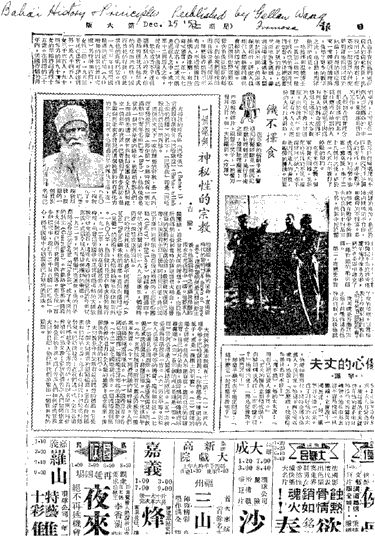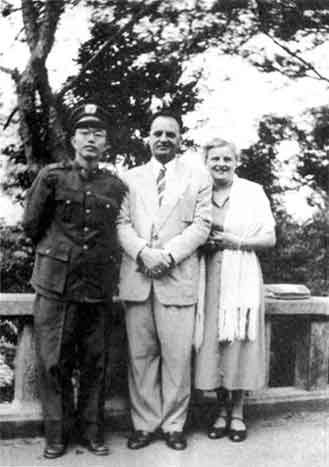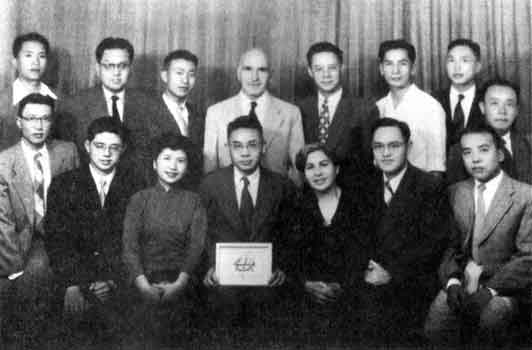
|
Taiwan Bahá'í Chronicle:
An Historical Record of the Early Days of the Bahá'í Faith in Taiwan
by Barbara R. Sims
 |
chapter 1 | start page | single page | chapter 3 |  |
Chapter 2
2. Further Beginnings, Including the First
Visit
to Taiwan By a Hand of the Cause
After the New Delhi Conference in 1953 the Hands of the Cause who attended the conference visited other areas to assist in the development of the Faith. In October of that year Mr. Zikrullah Khádem visited Taiwan, the first Hand of the Cause to do so. Mr. Jerome Chu (Chu Yao-lung) related that he had a meeting for Mr. Khádem at his home. As a result three people declared their belief in Bahá'u'lláh: Professor Tsao Li-shih, who was an instructor of architecture at Taiwan Engineering College; Mr. Hong Li-ming (Jimmy), the first native-born Taiwanese to become a Bahá'í; and Mr. Wong Ho-len (Wong Ho-jen). Mr. Khádem was the first Hand of the Cause to visit Macau during the same trip. He also went to Japan. During the time he was in Taiwan, Mr. and Mrs. Carl Scherer stopped over on their way to pioneer to Macau.
When Mr. and Mrs. Suleimani arrived in 1954 they found there was already a community of ten Chinese Bahá'ís, residing in various areas: in Taipei (2), Tainan (4), Tao-yuan, Tsoying and Chia-yi. Mr. Suleimani soon met eight of those Bahá'ís. He and his wife decided to settle in the southwestern city of Tainan where they rented a two-room apartment.
The first believer in Taiwan was Mr. Jerome Chu, a newspaper man, who had become a Bahá'í in Washington D.C. in 1945 after being taught by Mrs. Miriam Haney and Mr. and Mrs. Edwin Barham. Mr. Chu received a letter from the Guardian which ended with a message in his handwriting, "May the beloved bless your efforts, guide your steps, remove all obstacles from your path, and enable you to promote, effectively and under all conditions, the vital interests of His glorious Faith. Your true brother, Shoghi."
Mr. Chu, in a letter to Mr. and Mrs. Barham in 1953, wrote that the fireside meetings in the Barham' s apartment were the best times in his life. Mr. Chu had known Mr. and Mrs. Suleimani in Shanghai in 1949 and they kept in touch.
According to Mr. Suleimani, in 1949 the first four Chinese Bahá'ís arrived in Taiwan from the mainland to work as government employees. They were Mr. Chu, Maj. Chien Tien-lee (Maj. Lee L.T. Chang) who became a Bahá'í in the United States, and Mr. Mason Yuan (Yuan Mien-hsien) who became a Bahá'í through Mrs. Haney in 1947. Mr. Yuan told the Suleimanis, "Mother Haney taught me for a whole year every evening." He said that he had never felt such love and kindness. The fourth Bahá'í to arrive from the mainland was Mr. Yuan Hsu-chang,
6
 |
| (click for larger picture) |
On December 15, 1953 there was an article published in the Chung Hwa Daily News which had a photo of 'Abdu'l-Bahá and some history and principles of the Faith. This is no doubt the first publication about the Faith in a newspaper in Taiwan. The article was written by Mr. Gellan Wang.
7
There was another believer in Tainan, Mr. Gellan Wang (Wang Tzu-nan), who had become a Bahá'í in the United States in 1947. He worked in the Foreign Office in Taipei.
 |
| (click for larger picture) |
Hand of the Cause Mr. Khádem on his first trip to Taiwan, November 17, 1953, with Lt. Col. Yuan Mien-hsien (Mason) and Mrs. Loretta Scherer. The Scherers stopped at Taiwan on their way to their pioneer post of Macau. Lt. Col. Yuan had become a Bahá'í in the United States in 1947.
8
The early Bahá'ís, including the three who came into the Faith through Mr. Khádem in 1953, were quite staunch and their names can be found in reports of activities in the early years.
Mr. and Mrs. Edwin Barham, described by Miss Agnes Alexander as being teachers of Mr. Chu and Mr. Wang, received a letter written on behalf of the Shoghi Effendi by R. Rabbani. It was dated July 28, 1954 and was sent to the Barham's home in Washington, D.C.
"Your welcome letter of June 21st with enclosures was received, and the beloved Guardian has instructed me to answer you on his behalf.
"He was delighted to learn of the excellent work Mr. Chu and Mr. Wang are
 |
| (click for larger picture) |
Naw-Rúz Party at Tainan, 1955 Seated: Mr. Ho Cheng-tzu, Mr. Wong Ho-len, Mrs. Ruthy Tu, Mr. Jerome Chu, Mrs. Suleimani, Mr. Gellan Wang, Mr. Tsao Li-shih. Standing: Mr. Wang Chi-chang, Mr. Pai Chung-cheng, Mr. Tai Tung-ko, Mr. S.A. Suleimani, Mr. Liu H.Y. Mr. Luk Yun-shen (Winston), Mr. Cheng Chen-chang, Mr. Hsiao Tsan-chang (Johnson).
9
"When we realize what promise Formosa holds for the future, and that only a few years ago the Cause was unknown there, we can truly say miracles happen before our very eyes!
"The Guardian hopes you will be able to go to Formosa and help establish the projected assemblies there, and he urges you to keep in close touch with these two dear Bahá'ís. He is placing the newspaper article you forwarded in the Mansion Library at Bahji."
The Suleimanis started a study class as the Chinese felt they were not familiar with some aspects of the Faith. Several months later, on the evening of Naw-Rúz 1955, four people declared their Faith: Mr. Ho Cheng-tzu of Chia-yi, who several years later was to become the designer of the Tainan Bahá'í Center; Mr. Cheng Chen-chang of Taipei, who was in newspaper work; Mr. Pai Chung-cheng of Tainan; and Mr. Hsiao Tsan-chang (Johnson) of Chia-yi. Mr. Suleimani wrote that this was the most precious Naw-Rúz present bestowed on the island. This group was also quite active through the years.
In May 1955 Mr. Suleimani wrote that Capt. Shih Hung-mok, of Kangshan, declared his belief at Ridván. He was an active promoter of the Faith and helped with the printing.
At that time there were eighteen Bahá'ís in six localities, and it soon climbed to twenty-one believers.
In 1955 Mrs. Suleimani wrote a letter to Rúhiyyih Khánum and received a warm answer, quoted here in part, "Your most welcome letter of April 6 was received as well as the photographs you sent and I can assure you and your dear husband that the news you give of the progress of our Faith in Formosa has brought much joy to the heart of our beloved Guardian. I wish all the news he gets could make him as happy! ... it is only the good news — such as you send him — which lifts up his heart and enables him to carry on with his heavy tasks."
 |
chapter 1 | start page | single page | chapter 3 |  |
|
|